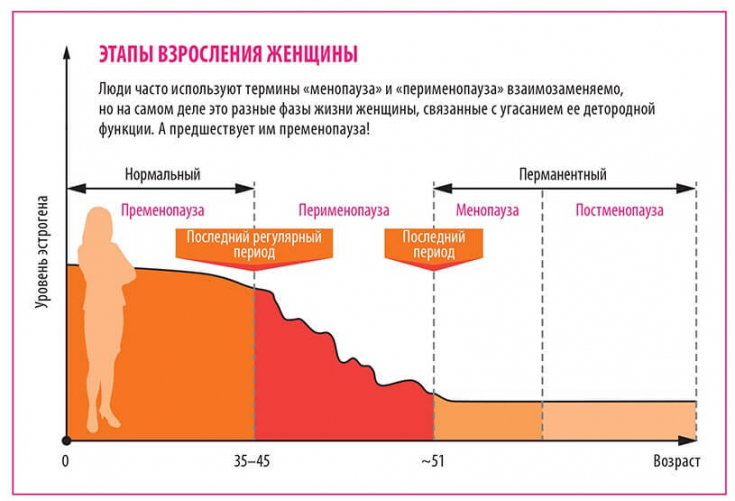According to recent studies, vitamin D plays a role not only in the control of calcium-phosphorus metabolism, but is also of great importance in the pathogenesis of cardiovascular and neurological diseases, insulin resistance and diabetes mellitus, in the development of cancer and autoimmune conditions , especially in menopausal women.
Find out in the article on estet-portal.com what health and well-being disorders can be solved by correction of vitamin D levels in women during menopause.
- Mechanisms of disruption of the woman's body during menopause
- Genital and extragenital disorders in pathological menopause
- Vitamin D levels during menopausess
Mechanisms of disruption of the woman's body during menopause
It is known that the time of onset and the degree of manifestation of menopausal symptoms are individual, and the period of perimenopauseis structured and covers premenopause (several years preceding menopause, when endocrinological and clinical signs of functional decline are observed ovaries), menopause (last menstruation, which is retrospective), and one year after menopause.
Follow us on Instagram!
Pathogenetic mechanisms that lead to menopausal disorders are the result of a failure of the main algorithm for the functioning of the female reproductive system: cyclical secretion of estrogen, progesterone, gonadotropic hormones.
Causes and prevention of osteoporosis during menopause
Such age-related changes are an important reason for the appearance of menopausal symptoms, progressionof gynecological pathology, worsening of the course of extragenital pathology.
Genital and extragenital disorders in the pathological course of menopause
A significant negative impact on the health of women of late reproductive age, as well as during menopause, unsatisfactory socio-economic living conditions was studied and reported, which further leads to the occurrence of extragenital pathology (lesions of the cardiovascular, digestive, urinary, autoimmune systems and metabolic disorders, etc.) and is observed in 60% of cases, and in 2/3 of the patients this pathology is chronic.

In women of this age category, there is an increase in the number of gynecological pathologies, which, according to studies by individual authors, ranges from 45 to 65%:
- pelvic inflammatory disease in 50-55% of cases;
- uterine fibroids;
- genital prolapse;
- menstrual irregularities.
Critical periods in a woman's life: postpartum and perimenopause
Oncological diseases of the reproductive system of women at this age, oncological lesions of other organs and systems predominate.
Vitamin D levels during menopause
Vitamins play an important role in the physiological processes of the body at different stages of a person's life, and their deficiency is associated with a number of pathological conditions. In recent years, intensive scientific research has established that vitamin D functions are not limited to the control of calcium-phosphorus metabolism.
Its level in the body affects other physiological processes such as:
- modulation of cell growth;
- neuromuscular conduction;
- immunity;
- inflammation.
The expression of a large number of genes that encode proteins and are involved in proliferation, differentiation and apoptosis is also regulated by vitamin D.

According to current research, vitamin D is also a hormone that plays a significant role in pathogenesis:
- cardiovascular diseases;
- neurological disorders;
- insulin resistance and diabetes mellitus;
- cancer development;
- autoimmune conditions.
Vitamin D deficiency, according to experts of the International Society of Endocrinology, is determined at a level of 25 (OH) D in blood serum less than 20 ng / ml, levels between 20- 30 ng/ml should be regarded as vitamin D deficiency and optimum − more than 30 ng/ml, especially for elderly patients.
An increase in the number of overweight women leads to an increase in the prevalence of vitamin D deficiency, which is associated with its deposition in subcutaneous fat and inaccessibility to the central bloodstream.
Other causes of vitamin D deficiency are digestion and absorption disorders. The issue of the spread of vitamin D deficiency in women living in regions with different climatic and geographical characteristics is an important problem and requires further study.
25(OH)D is hydroxylated in many cells to the active form ?minus; 1,25 (OH) 2 D, which acts locally inducing cell differentiation and angiogenesis and suppressing invasive cell growth.
What should be considered when prescribing hormone replacement therapy?
WHO published a review on the relationship between vitamin D and cancer in 2008 and pioneered research in this regard.
A growing body of research suggests that vitamin D may play a role in the prevention and treatment of type 1 diabetes, glucose intolerance, hypertension, multiple sclerosis, and vascular and neurological disorders in menopausal pathology.
Therefore, timely correction of the level of this vitamin can be a qualitative prevention of the development of osteoporosis, arterial hypertension, as well as an increase in the number of neoplasms during menopause.
For more useful information, see our YouTube-channel:







Add a comment